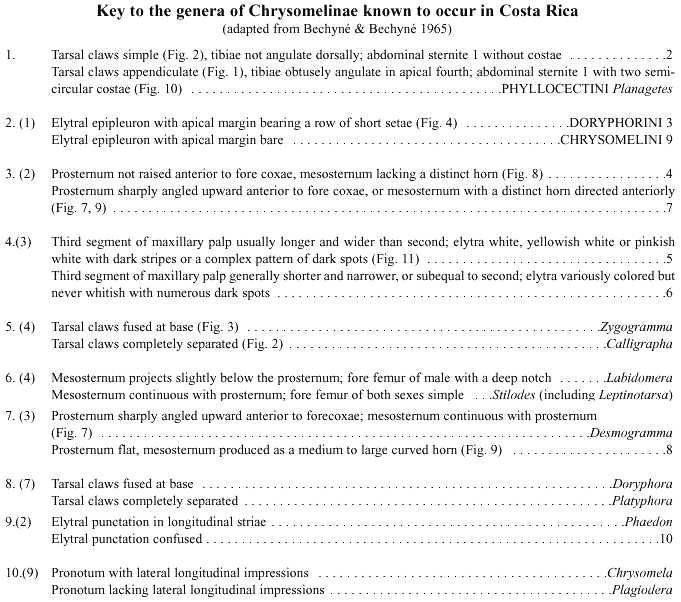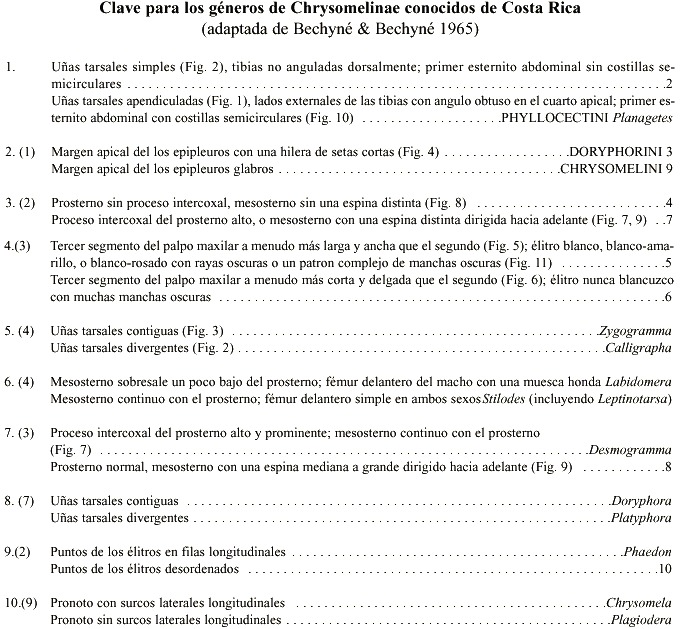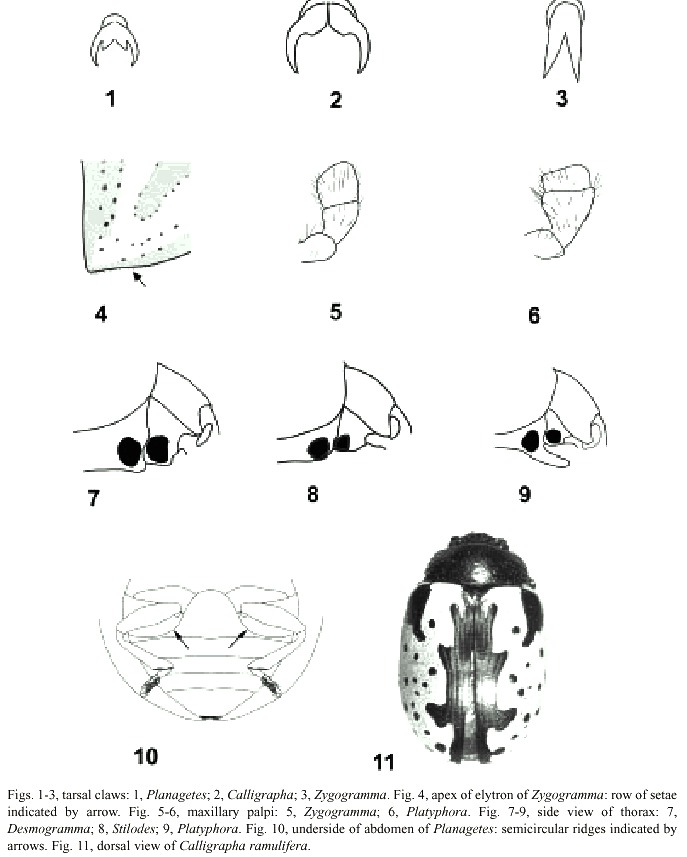Services on Demand
Journal
Article
Indicators
-
 Cited by SciELO
Cited by SciELO -
 Access statistics
Access statistics
Related links
-
 Similars in
SciELO
Similars in
SciELO  uBio
uBio
Share
Revista de Biología Tropical
On-line version ISSN 0034-7744Print version ISSN 0034-7744
Rev. biol. trop vol.52 n.1 San José Mar. 2004
The genera of Chrysomelinae (Coleoptera: Chrysomelidae) in Costa Rica
R. Wills Flowers
Center for Biological Control, Florida A&M University, Tallahassee, FL 32307 USA; rflowers@mail.istal.com
Abstract
Keys in Spanish and English are given for the genera of Chrysomelinae known from Costa Rica. For each genus, a list of species compiled from collections in the University of Costa Rica, the National Biodiversity Institute, and the entomological literature is presented. The genus Planagetes Chevrolat 1843 is recorded for the first time from Central America, and the genus Leptinotarsa Stål 1858 is synonymized with Stilodes Chevrolat 1843.
Key words: Chrysomelinae, keys, Planagetes, Stilodes, Leptinotarsa.
Members of the subfamily Chrysomelinae –popularly known in Costa Rica as "confites con patas" (walking candies)– are among the largest and most colorful representatives of the family Chrysomelidae in Costa Rica. They are of broad ecological interest because of their host plant preferences and varying modes of life. Although readily noticed, there are no keys to the Neotropical fauna for identification of either species or genera, and many taxonomic problems persist in this subfamily. The only recent generic key for this region was published in 1965 by Jan and Bohumila Bechyné for Venezuela. To assist present and future workers studying this group, a modified version of their key for genera known to occur in Costa Rica is presented in English and Spanish. This is followed by notes on the diversity of the individual genera in Costa Rica with a list of both species identified in the collections of the University of Costa Rica and the National Biodiversity Institute (INBio) and those recorded from Costa Rica in the catalogs of Blackwelder (1947) and Bechyné (1952), along with a discussion of the taxonomic status of Stilodes and Leptinotarsa.

Calligrapha Chevrolat 1837
Adult specimens of all species have white, pale yellow, or pale rose elytra with intricate patterns of dark markings. Twelve species are presently known from Costa Rica:
Calligrapha argus StålCalligrapha diversa (Stål)
Calligrapha elegantula Jacoby
Calligrapha fulvipes Stål
Calligrapha gyllenhali Stål
Calligrapha notatipennis Stål
Calligrapha pantherina Stål
Calligrapha ramulifera Stål
Calligrapha serpentina (Rogers)
Calligrapha sponsa Stål
Calligrapha subdentata Bechyné
Calligrapha tortilis Stål
Chrysomela Linné 1758
Desmogramma Erichson 1847
One species, Desmogramma conjugata Stål, is known from Costa Rica.
Doryphora Illiger 1807
Two species occur in Costa Rica and are the largest members of the Costa Rican chrysomelid fauna.
Doryphora bioleyi (Achard)
Doryphora paykulli (Stål)
Labidomera Chevrolat 1837
One species, Labidomera suturella Guérin-Méneville occurs in Costa Rica. Choe (1989) reported maternal care in this species.
Phaedon Latreille 1829
Phaedon cyanescens Stål
Phaedon mexicanum Jacoby
Phaedon ruficeps Achard
Plagiodera Chevrolat 1837
Plagiodera atritarsis Stål
Plagiodera bistripunctata Duvivier
Plagiodera quadrimaculata Jacoby
Planagetes Chevrolat 1843
One species, Planagetes uniformis (Jacoby) new combination occurs in Costa Rica. Jacoby described this species in Plagiodera, noting its small round body out-line and its similarity to a coccinellid. However, this species has appendiculate claws and angulate tibia, both characters of Planagetes (Bechyné & Bechyné 1965). This is a new Central American generic record. Along with its coccinellid-like habitus, P. uniformis has semi-circular costae on the first abdominal sternum behind the metacoxae (Fig. 10), a character also found in many Coccinellidae.
Platyphora Gistl 1857
This is the largest genus of Chrysomelinae in Costa Rica. Twenty-three species are known and many as-yet unidentified specimens have also been collected. Vivipary has been observed in at least two Costa Rican species and is known from a number of South America species. However, the biology of most of the species is still unknown.
Platyphora arangoi (Jacoby)Platyphora bicolor (Jacoby)
Platyphora biremis (Stål)
Platyphora decorata (Jacoby)
Platyphora decurrens (Stål)
Platyphora eucosoma (Stål)
Platyphora flavoguttata (Jacoby)
Platyphora ligata (Stål)
Platyphora macrogramma Bechyné
Platyphora nigroguttata (Stål)
Platyphora nr. lativittis (Jacoby)
Platyphora ocellata (Jacoby)
Platyphora ornata (Jacoby)
Platyphora panamensis (Jacoby)
Platyphora petulans (Stål)
Platyphora punctipennis (Jacoby)
Platyphora purulensis (Jacoby)
Platyphora rogersi (Jacoby)
Platyphora salvini (Baly)
Platyphora selva Daccordi
Platyphora semiviridis (Jacoby)
Platyphora spectabilis (Stål)
Platyphora spectanda (Stål)
Platyphora uniformis (Jacoby)
Stilodes Chevrolat 1843
Leptinotarsa Stål 1858 new synonymy
Although it contains one of the most studied animals on Planet Earth, the genus Leptinotarsa has never been adequately differentiated from other genera in the Doryphorini. Given the enormous economic impact of the Colorado Potato Beetle, Leptinotarsa decimlineata (Say), and the increasing interest in finding some alternative to pesticide control, it is strange that the status of the genus Leptinotarsa has not attracted more interest. Jacoby (1880-1892), in the Biologia Centrali Americana noted the high degree of similarity between Leptinotarsa and Stilodes and the difficulty in correctly assigning some of the Central American species. Stål (quoted by Jacoby) recognized Leptinotarsa on the basis of the last segment of the maxillary palp which he described as shorter than the penultimate, and truncate. Chapuis (1875) used the longer length of the tibial groove to separate Leptinotarsa. Bechyné and Bechyné (1965) used the form of the antennae; short and sub-clavate in Stilodes, filiform in Leptinotarsa. The only recent attempt at a taxonomic treatment was Jacques (1988) short booklet on Leptinotarsa, but this work ignored the species south of Mexico, and comparisons with other genera were limited to meaningless tabulations of species numbers among North American Doryphorini. Likewise, Hsiao (1988) compared Leptinotarsa only to other Nearctic Doryphorini. Neither author mentioned Stilodes.
After studying four species assigned to Leptinotarsa and seven species assigned to Stilodes in the INBio collection, I conclude that none of these characters is reliable. Most species in both these genera have the last two segments of the maxillary papli subequal, and in neither genus is the last segment consistently longer or shorter than in the other (they are truncate in all the species). Indeed, the last segment appears to be somewhat retractable into the third segment because in some specimens the length ratios are noticeably different from side to side.
The tibial groove is also an unreliable character. In species assigned to Leptinotarsa it purportedly runs down the entire apical half of the tibia while it is confined to the apical third in those of Stilodes. However, in all species the beginning of the groove is extremely shallow somewhere between the apical half or third of the tibia. The angle of the light can often change the point at which the groove appears to begin. Jacoby also noted the variability of this character.
Finally, there is no difference in shape of the antennae between the two genera in Costa Rica. All have the apical antennomeres somewhat thicker than the basal antennomeres.
Examination of the male and female genitalia also failed to provide any consistent characters for separation. The spermathecae of most of the species in both genera had the same general form, and showed as much intra-as intergeneric variation. The aedeagi were similar except for some differences in the apex of the median lobe. In Costa Rican Stilodes the lateral margins are sinuate (viewed from the side), while in Leptinotarsa they are evenly curved. At least one other species of Leptinotarsa, however, also has a sinuate apicolateral margin of the median lobe (Jaques 1988). Nor would the tip of the median lobe in and of itself be considered a valid way to separate genera in many other groups of Coleoptera.
Stilodes is a large and probably polyphyletic genus, largely South American in distribution. Both it and Leptinotarsa are in need of modern taxonomic revisions. For the present, there are no characters or combination of characters that reliably separate these taxa and hence no justification for keeping them as separate genera. Unfortunately for the applied entomological literature and those overly concerned with "taxonomic stability", Stilodes Chevrolat 1843 has nomenclatural priority.
Stilodes belti (Jacoby)
Leptinotarsa belti Jacoby new synonymy
Stilodes decimlineata (Say)
Leptinotarsa decimlineata Say
new synonymy
Stilodes evanescens (Stål)
Leptinotarsa evanscens Stål
new synonymy
Stilodes flavitarsis (Guerin-Meneville)
Leptinotarsa flavitarsis Guerin-Meneville
new synonymy
Stilodes fuscolineata (Stål)
Leptinotarsa haldemani Rogers
new synonymy
Stilodes leoparda Jacoby
Stilodes modesta Jacoby
Stilodes motschulkyi Stål
Stilodes neptis (Stål)
Stilodes panamensis Jacoby
Stilodes quadristriata Jacoby
Stilodes undecimlineata (Stål)
Leptinotarsa undecimlineata Stål
new synonymy
Zygogramma Chevrolat 1837
Species in this genus have Calligrapha – like markings of white to yellowish white, overlain with dark stripes or irregular blotches.
Seven species have been recorded from Costa Rica and several more unidentified ones are in the INBio material.
Zygogramma bigenera (Stål)
Zygogramma curvatolineata Jacoby
Zygogramma guttulosa (Stål)
Zygogramma picecollis Stål
Zygogramma popa (Stål)
Zygogramma signatipennis (Stål)
Zygogramma violaceomaculata (Jacoby)
Acknowledgments
This study was funded by the Costa Rica National Biodiversity Inventory and the Biodiversity Resources Development Project, GEF/World Bank. This study was also funded in part by a grant (FLAX 91005) from CSREES, USDA to Florida A&M University.
Resumen
Se presenta claves en español y inglés para los géneros de Chrysomelinae conocidas de Costa Rica. Para cada género, se presenta una lista de especies compiladas de las colecciones de la Universidad de Costa Rica, el Instituto Nacional de Biodiversidad, y la literatura entomológica. El género Planagetes Chevrolat 1843 está registrado por primera vez de América Central, y el género Leptinotarsa Stål 1858 está sinonomizado con Stilodes Chevrolat 1843.
References
Bechyné, J. 1952. Nachträge zu de Katalogen von Blackwelder und Junk-Schenkling der neotropischen echten Chrysomeliden (Col. Phytophaga). Entomologische Arbeiten aus dem Museum G. Frey 3: 1-62. [ Links ]
Bechyné, J. & B. Springlová de Bechyné. 1965. Notes sur les Chrysomelidae s. str. de Venezuela et des pays limitrophes. Revista de la Facultad de Agronomía (Maracay) 3: 44-110. [ Links ]
Blackwelder, R.E. 1947. Checklist of the coleopterous insects of Mexico, Central America, the West Indies, and South America. Smithsonian Institution, United States National Museum Bulletin 185, Part 4: 551- 763. [ Links ]
Chapuis, F. 1875. In Histoire Naturelle des Insectes. Genera des Coléoptères. T. Lacordaire & F. Chapuis (eds.) 11: 1-420. [ Links ]
Choe, J.C. 1989. Maternal care in Labidomera suturella Chevrolat (Coleoptera: Chrysomelidae) from Costa Rica. Psyche 96: 65-67. [ Links ]
Hsiao, T.H. 1988. Host specificity, seasonality and bionomics of Leptinotarsa beetles. In P. Jolivet, E. Petitpierre and T.H. Hsiao (eds.). Biology of Chrysomelidae. Kluwer Academic Publishers. Dordrecht. 615+xvii pp. [ Links ]
Jacoby, M. 1880-1892. Biologia Centrali-Americana, Insecta, Coleoptera, vol. 6, pt. 1; Suppl. 1-168; 1-348 [ Links ]
Jaques, R.L. 1988. The potato beetles. Flora & Fauna Handbook No. 3. E.J. Brill, Leiden, 144 p. [ Links ]
















